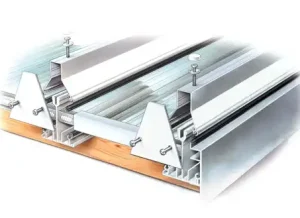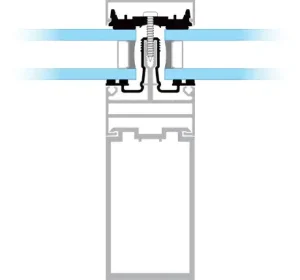Types of Glazing Bars We Manufacture

Glazing Bars For Glass
Lonsdale offers a wide range of glazing bars for single glazing, double glazing and triple glazing. These vary in appearance from traditional to modern, white or brown, and both self-supporting glazing bars and glazing bars suitable for fixing on top of timber rafters are available.
Various type of glazing bars are available:
Traditional Inverted T Bars are glazing bars featuring an upside down ‘T’ shape with either continuous beads or a snap or screw on capping to retain the glass. Examples are our SkyGard Glazing bars and PlasGard Glazing Bars
Box-Bar Glazing Bars have the advantage of thermal breaks so offer better insulation values and reduce risk of condensation in heated spaces. See our ThermGard Glazing Bars

Self Supporting Glazing Bars
For a contemporary and cost effective solution to your glazing needs and the perfect addition to carports and conservatories and lean to roofs, self supporting glazing bars can be installed without the need for supporting rafters or frames. The Lonsdale range of self-supporting glazing bars consists of various size sections to short long and short spans. Typical maximum spans are 4000mm for single glazing and 5000mm for double glazing subject to design wind & snow loads.
Learn about our self supporting glazing bar solutions for porticos, conservatories, lean tos, canopies and other structures.

Traditional Patent Glazing Bars
Lonsdale patent glazing bars have been installed at some of the most prestigious and important heritage and conservation buildings throughout the UK. These include Buckingham Palace, Cliveden, St James’s Palace, Windsor Castle, The British Museum, 10 Downing Street, Holyrood Palace, The V&A Museum, Marble Arch and Clarence House.
The installation of glazing bars for conservation and heritage rooflights requires careful consideration as it is important any design is in keeping with the original fabric of the building. Various glass types can be installed into glazing bars which offer UV protection and solar shading, sometimes important considerations to avoid degradation of the interiors, furniture or exhibits within the precious buildings.
Discover the benefits of our traditional glazing bars

Glazing Bars for Polycarbonate
A range of glazing bars for polycarbonate, approved by all manufacturers of polycarbonate sheets, are available both self-supporting and suitable for fixing on top of timber rafters. Due to the flexible nature of polycarbonate it is vital the sheets are securely clamped in place and Lonsdale glazing bars for polycarbonate feature wider rebates and screw on cappings for robust installation. Critically, the gasket used in glazing bars must be compatible with the polycarbonate to avoid chemical migration which can prove detrimental over time both in terms of performance and appearance.
See our PlasGard glazing bars for polycarbonate.

Rafter Supported Glazing Bars
Rafter supported glazing bars provide a watertight seal with integrated gaskets and drainage for high performance weathering Lonsdale offers glazing bars for timber rafters in both contemporary and heritage styles.
Read more about our rafter supported glazing bars.

Aluminium Rooflight System
Discover our Safegard TG-50 Aluminium Rooflight System. We can cut to size to ensure that your aluminium rooflight is perfectly tailored to your property needs. Get weather tight, high performance aluminium rooflights for your commercial of domestic space.
Read more about our aluminium rooflight systems.
Get Your Glazing Bar Quote Today
Contact our team today to start your journey towards high quality roof windows, skylights and glass roofs.
For glazing bars and accessories, look no further than our team at Lonsdale Metal.

Glazing bars first came into common use towards the end of the 19th Century. The most famous example which survives today is Crystal Palace built for the Grand exhibition in 1851 and features hundreds of glazing bars.
Other notable buildings of the time are Kew Gardens, Chatsworth’s Great Conservatory and The Glasshouse at Down House
Traditionally glazing bars were made from timber or steel and glazed with putty. Technology at the time did not allow glass panels to be manufactured in large sizes, so glazing bars were typically installed at 600mm spacings and often the glass was simply over-lapped in the glazing bar rebate. This was a common feature of fashionable conservatories at the time.
The British Standard Code of Practice For The Design & Installation of Sloping & Vertical Patent Glazing defines a glazing bar as a ‘longitudinal supporting member in patent glazing that spans between structural members and incorporates water channels’.
Check out our easy to follow Installation Videos for Glazing Bars here:
Lonsdale Patent Glazing & Rooflights – YouTube
The integral drainage channels in glazing bars are an essential feature as any water penetrating the system drains harmlessly out the bottom of the glazing bars to the outside of the building. Many modern patent glazing bars feature high performance cappings, such as PVC top caps, and gaskets that prevent water ingress and some systems can achieve exceptional weather-tightness ratings up to E1650 as designated in BSEN12208
At Lonsdale we recommend glazing bars are installed at a minimum pitch of 15 degrees for optimum weather-tightness and also at this pitch rain water flows faster enough to carry debris off the glass roof so the glazing bars and glass remain cleaner. However, glazing bars are available that can be installed as low as 5 degree pitch and still remain weather-tight.
Where you require glazing bars for a domestic, commercial or heritage project our expert team is here to help and provide a cost effective solution for your building.
Contact our team today to start your glazing bar installation process!
Frequently Asked Questions
Why Choose Lonsdale Metal for Your Glazing Bars?
With over 70 years of experience in the glazing industry, Lonsdale Patent Glazing and Rooflights are committed to enabling you to build safe, durable and watertight roof windows, roofs and skylights.
Our team is highly qualified, with offices in London, Exeter, Birmingham, Manchester and Glasgow to assist customers nationwide with the design and installation of our glazing bar products. Our nationwide delivery ensures that you can have the perfect glazing bars for your structures wherever you are in the country.
What Are the Benefits of Installing Glazing Bars?
Cost Effective
Glazing bars provide a cost effective method for installing glass overhead be that in a simple domestic roof window, or large commercial rooflight.
Aesthetics
Frames and rafters can also give aesthetic appeal. By selecting an aluminium base, or even wood or other materials, you can enhance the appearance of roof windows, skylights and roofs effortlessly.
All our glazing bars are available in a range of architectural finishes including polyester powder coating to suit all structures.
Durability
Correctly installed, glazing bars offer many years of good service. There are many glass roofs installed many years ago still showing fantastic structural integrity. Maintenance is minimal, but provided they are regularly cleaned, glass roofs featuring aluminium glazing bars can have a design life of forty years or more.
Energy Saving Benefits
Modern glazing bars are installed with hermetically sealed double glazed or triple glazed units providing excellent insulation.
Modern systems offer excellent air-permeability enabling easier control of the building’s environment. Careful design brings many benefits from natural daylight and this combination with insulating glass units means significant savings can be made both in terms of lighting, heating and ventilation.
Where are glazing bars commonly found?
Glazing bars make a great addition to a wide range of both commercial and domestic structures. They’re most typically found in conservatories, greenhouses, and glass roofing features in commercial properties like train stations, museums, and shopping centres.
Are glazing bars structural or decorative?
Glazing bars serve both a structural and decorative purpose. Not only do they support the weight of glass and provide greater strength and rigidity, they also help to enhance the aesthetics of a building.
About Lonsdale
Established in 1946, Lonsdale remains a market leading manufacturer of glazing bars for overhead glazing. Important buildings where our systems have been chosen as the best available include Buckingham Palace, Windsor Castle, St Pancras & Kings Cross Stations, The British Museum and homes for eminent people including Sir Rod Stewart, Sir Iain McKellen and Sir James Dyson. As members of The Rooflight Association, Lonsdale are key advisors to The British Standards Institute and Government in terms of pioneering Building Regulations and improving standards. We place key emphasis on providing our customers great quality products, exceptional value and outstanding service. Our experienced team plays a key role in providing practical and technical advice to customers, so please do not hesitate to contact us with details of your glazing bar project.




